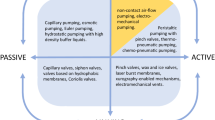Abstract
Liquids flow control plays a critical role in the designing of microfluidic networks for utilizing in the lab-on-a-chip devices as a modern platform for miniaturizing and automating medical diagnostic tests. In some applications such as immunoassay, it is essential to use different samples and reagent liquids in a series of sequential steps based on the test procedures. Thus far, a number of studies have reported associated methods mostly employing a different kind of the micro-valves. We introduce the concept of a dual-chamber, a passive method for the sequential entrance of any kind of liquids into a chamber in centrifugal microfluidics. The mechanism relies on the ability of the liquid pumping by employing its rotational potential energy through an abrupt angular deceleration of the containing disk. The model is analyzed theoretically, numerically and experimentally for optimizing the geometrical design to reach to the maximum liquid transfer efficiency. Furthermore, a model comprising of several dual-chamber units is presented and experimented based on the optimized designs. The results show that the presented method has a high ability of precise and efficient liquid transfer in the centrifugal microfluidic platforms through a simple and highly integrated approach.













Similar content being viewed by others
References
Ansys Fluent (2009) 12.0 user’s guide. Ansys Inc., Canonsburg
Godino N et al (2013) Comprehensive integration of homogeneous bioassays via centrifugo-pneumatic cascading. Lab Chip 13(4):685–694
Hoffmann J et al (2010) Pre-storage of liquid reagents in glass ampoules for DNA extraction on a fully integrated lab-on-a-chip cartridge. Lab Chip 10(11):1480–1484
Kazemzadeh A, Eriksson A, Madou M, Russom A (2019) A micro-dispenser for long-term storage and controlled release of liquids. Nat Commun 10(1):189
Kitsara M et al (2014) Spin coating of hydrophilic polymeric films for enhanced centrifugal flow control by serial siphoning. Microfluid Nanofluidics 16(4):691–699
Lee BS et al (2009) A fully automated immunoassay from whole blood on a disc. Lab Chip 9(11):1548
Lutz S et al (2010) Microfluidic lab-on-a-foil for nucleic acid analysis based on isothermal recombinase polymerase amplification (RPA). Lab Chip 10(7):887
Madou M et al (2001) Design and fabrication of CD-like microfuidic platforms for diagnostics: microfuidic functions. Biomed Microdevice 3:245–254
Meng X et al (2017) Conditional siphon priming for multi-step assays on centrifugal microfluidic platforms. Sens Actuators B Chem 242:710–717. https://doi.org/10.1016/j.snb.2016.11.063
Meriam JL, Glenn Kraige L (2012) 2 Engineering mechanics: dynamics. Wiley, New York
Nwankire CE et al (2013) At-line bioprocess monitoring by immunoassay with rotationally controlled serial siphoning and integrated supercritical angle fluorescence optics. Anal Chim Acta 781:54–62. https://doi.org/10.1016/j.aca.2013.04.016
Pishbin E et al (2016) The effect of moment of inertia on the liquids in centrifugal microfluidics. Micromachines 7(12):1–12
Riegger L et al (2006) Read-out concepts for multiplexed bead-based fluorescence immunoassays on centrifugal microfluidic platforms. Sens Actuators A 126(2):455–462
Schaff UY, Sommer GJ (2011) Whole blood immunoassay based on centrifugal bead sedimentation. Clin Chem 57(5):753–761
Shamloo A, Madadelahi M, Akbari A (2016) Numerical simulation of centrifugal serpentine micromixers and analyzing mixing quality parameters. Chem Eng Process 104:243–252. https://doi.org/10.1016/j.cep.2016.03.017
Siegrist J et al (2010) Serial siphon valving for centrifugal microfluidic platforms. Microfluid Nanofluidics 9(1):55–63
Strohmeier O et al (2015) Centrifugal microfluidic platforms: advanced unit operations and applications. Chem Soc Rev 44(17):6187–6229
Tang L, Lee NY (2010) A facile route for irreversible bonding of plastic-PDMS hybrid microdevices at room temperature. Lab Chip 10(10):1274–1280
Ukita Y, Takamura Y, Utsumi Y (2015) Water-clock-based autonomous flow sequencing in steadily rotating centrifugal microfluidic device. Sens Actuators B Chem 220:180–183. https://doi.org/10.1016/j.snb.2015.05.051
Ukita Y et al (2012) Stacked centrifugal microfluidic device with three-dimensional microchannel networks and multifunctional capillary bundle structures for immunoassay. Sens Actuators B Chem 166–167:898–906. https://doi.org/10.1016/j.snb.2012.03.028
Yusoff NA, Soin N, Ibrahim F (2009) Lab-on-a-disk as a potential microfluidic platform for dengue NS1-ELISA. In: 2009 IEEE symposium on industrial electronics and applications, ISIEA 2009—Proceedings 2(ISIEA), pp 946–50
Zohrehvandi D (2017) A new mechanism for the plasma separation from whole blood on the lab-on-a-disk systems based on moment of inertia method. In: 2017 24th national and 2nd international Iranian conference on biomedical engineering (ICBME) (December), pp 330–333
Acknowledgements
This work was supported and Granted by the Iran National Science Foundation (no. 95849409).
Author information
Authors and Affiliations
Corresponding author
Additional information
Publisher’s Note
Springer Nature remains neutral with regard to jurisdictional claims in published maps and institutional affiliations.
Rights and permissions
About this article
Cite this article
Fakhari, S., Pishbin, E., Navibakhsh, M. et al. Implementing series of dual-chamber units for sequential loading of the liquids in centrifugal microfluidic platforms. Microfluid Nanofluid 23, 53 (2019). https://doi.org/10.1007/s10404-019-2222-1
Received:
Accepted:
Published:
DOI: https://doi.org/10.1007/s10404-019-2222-1




